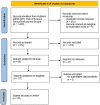Prevalence and risk of new-onset diabetes mellitus after COVID-19: a systematic review and meta-analysis
- PMID: 37732118
- PMCID: PMC10507325
- DOI: 10.3389/fendo.2023.1215879
Prevalence and risk of new-onset diabetes mellitus after COVID-19: a systematic review and meta-analysis
Abstract
Aims: After the acute phase of SARS-CoV-2 infection, the onset of glycemic impairment and diabetes have been reported. Nevertheless, the exact burden of glycemic impairment and diabetes after COVID-19 has not been clearly described.
Materials and methods: Electronic search was run in Pubmed (MEDLINE), Web of Science, Scopus, and ClinicalTrial.org for reports published from database inception to September 2022. We included observational studies reporting quantitative data on diabetes prevalence or its onset in subjects with a history of SARS-CoV-2 infection from at least 60 days. Risk of bias was assessed by the JBI's critical appraisal checklist. Random effect model was used to calculate pooled data. The review protocol was registered on PROSPERO (CRD42022310722).
Results: Among 1,630 records screened, 20 studies were included in the analysis. The mean or median age of participants ranged from ~ 35 to 64 years, with a percentage of males ranging from 28% to 80%. Only two studies were considered at low risk of bias. The estimate of diabetes prevalence, calculated on a total of 320,948 participants pooled with 38,731 cases, was 16% (95%CI: 11-22%). The estimate of proportion of incident cases of diabetes was 1.6% (95%CI: 0.8-2.7%). Subgroup analysis showed that previous hospitalization increased the prevalence of diabetes and the proportion of incident cases.
Conclusion: Diabetes is common in individuals who have experienced SARS-CoV-2 infection, especially if they required hospitalization. This data may be helpful to screen for diabetes and manage its complications in individuals who experienced COVID-19.
Systematic review registration: https://www.crd.york.ac.uk/prospero/display_record.php?ID=CRD42022310722, identifier CRD42022310722.
Keywords: COVID – 19; SARS-CoV2 (COVID- 19); diabetes; incidence; new onset diabetes; systematic review and meta-analysis.
Copyright © 2023 Bellia, Andreadi, D’Ippolito, Scola, Barraco, Meloni, Lauro and Bellia.
Conflict of interest statement
The authors declare that the research was conducted in the absence of any commercial or financial relationships that could be construed as a potential conflict of interest.
Figures





References
-
- Harding JL, Ali MK, Gander JC, Patzer RE. 174-LB: diabetes as a risk factor for long-COVID-19—a scoping review. Diabetes (2022) 71:174–LB. doi: 10.2337/db22-174-LB - DOI
Publication types
MeSH terms
LinkOut - more resources
Full Text Sources
Medical
Miscellaneous

